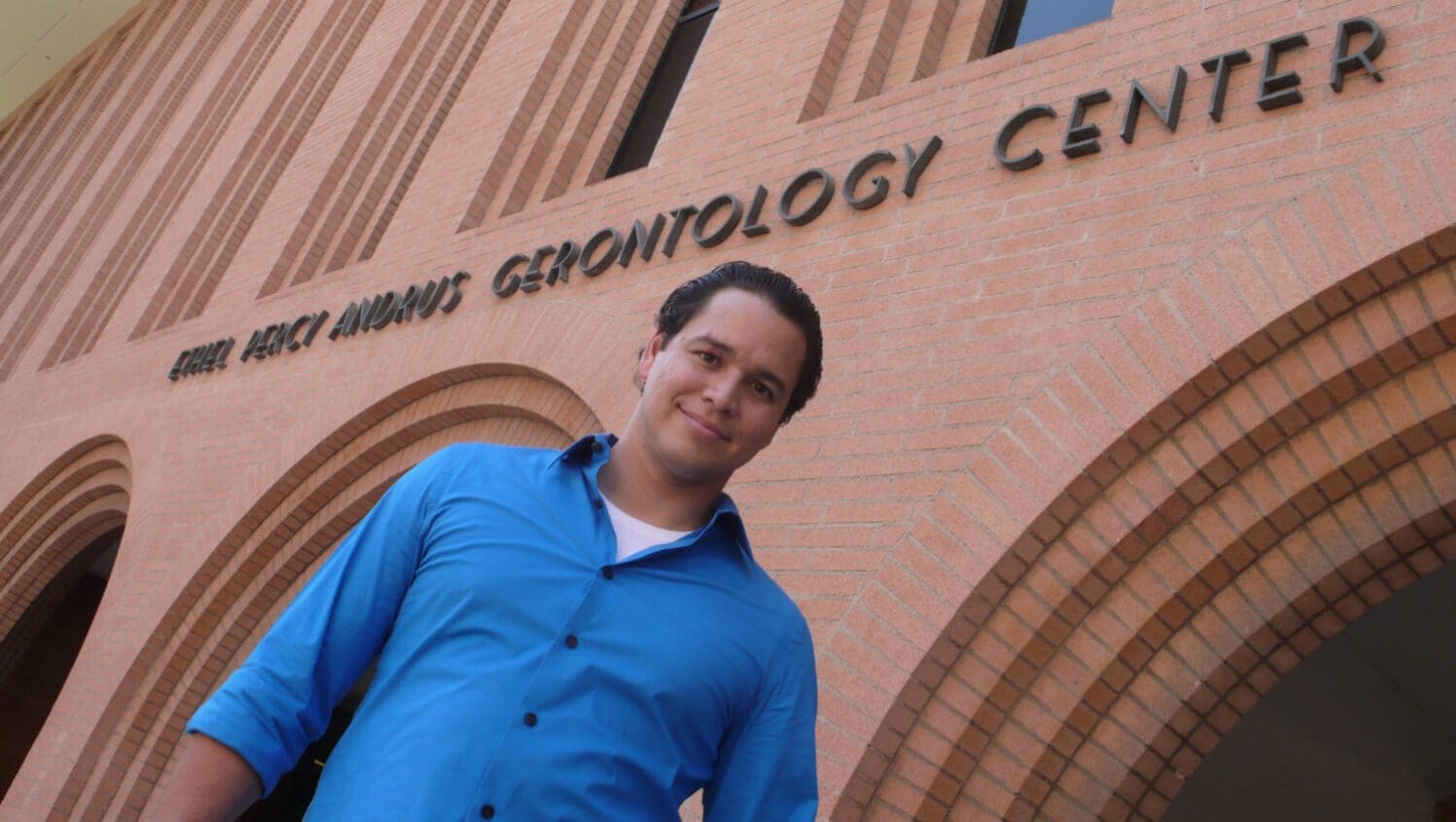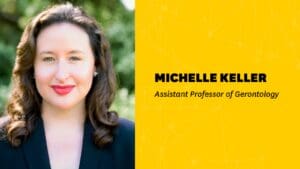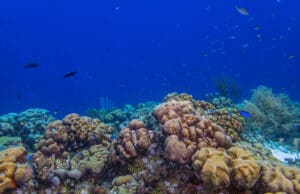The right kind of volunteering – at the right dose – can not only make you feel good; it also can make you healthier. Volunteering could be your ticket to healthy aging, improving your chances for a longer life with less disability. That’s the message coming out of research by a new crop of gerontologists – among them, University of Southern California gerontologist Tara Gruenewald, PhD, M.P.H. – who have moved the spotlight from age-related diseases to a more positive focus on healthy aging.
Kelvin Davies streamlined the submission process for one journal – now Elsevier is expanding Your Paper, Your Way across its entire portfolio.
In scholarly publishing as in life, the most complicated thing might be figuring out how to simplify. For two years, professor Kelvin Davies has quietly been revolutionizing how papers are submitted to academic journals, leaving scientists with more time to devote to actually conducting research.
The Vice Dean and James E. Birren Chair in Gerontology at the USC Leonard Davis School of Gerontology, and Professor of Molecular and Computational Biology at the USC Dornsife College of Letters, Arts and Sciences, Davies has been Editor-in-Chief of biomedical journal Free Radical Biology & Medicine for more than three decades, in which time he’s seen thousands of submissions from researchers. Davies has also been editor of three other biomedical journals and on the editorial board member for dozens of others.
Like most top scholarly journals, the acceptance rates at Free Radical Biology & Medicine are brutal: only about one-in-five submitted papers are published, and most are declined right away after a quick glance, the “desk reject” in publishing parlance.
But the journal still demanded a lot of specific formatting in advance of submission – “busywork” that Davies says had nothing to do with the content of the paper and that the editors of the journal spent a lot of time correcting. Authors would toil at formatting an article to a journal’s specifications, only to have to reformat it again if the paper was rejected for resubmission to another publication.
“We’re all scientists. We’ve all felt the frustration as authors of spending an awful lot of time on something that has nothing to do with the science,” said “Sir” Kelvin, who was knighted by the President of France in 2012, in honor of his critical role in uncovering the effects of free radicals and oxidative stress on aging processes [link: http://dornsife.usc.edu/news/stories/1170/usc-professors-cadenas-and-davies-knighted-by-france/].
In 2011, Davies began offering researchers the option of submitting their papers to Free Radical Biology & Medicine with whatever formatting made the most sense to them, so long as they included such crucial information as a title and abstract, methods, results and discussion, references and mandatory disclosures. Free Radical Biology & Medicine is the official journal of both the Society for Free Radical Biology & Medicine, based in the United States, and the European Society for Free Radical Research.
“From the beginning, when we took off our editor caps and put on our author caps, we thought this would be great, and we rather had the idea that other authors would think it was super as well,” Davies said.
The Your Paper, Your Way system devised by Davies, which also includes a more automated citation style, was then expanded to a trial group of 42 journals by Elsevier, the publisher of Free Radical Biology & Medicine and other leading journals such as Cell and The Lancet. The feedback, in an area of publishing traditionally resistant to change, was overwhelmingly positive: not a single piece of negative feedback from authors or reviewers. Most editors said they saw no difference in their workload.
Last month, Elsevier announced an expansion of the Your Paper, Your Way system to 800 of its publications, and by the end of the year it plans to roll out the program across their entire portfolio of 2,300 journals, freeing researchers to spend time on content instead of formatting, before the certainty of acceptance. Once the paper makes it to revision stage, authors are then asked to format for consistency.
“We should be focusing on the quality of science and not the format,” Davies said. “An easier submission process not only saves time and effort but may also allow authors to achieve faster publication speeds. There is no downside to it.”
USC Leonard Davis School alum Lauren Iwata won a prestigious honor: being named 2013 Nisei Week Queen. According to its website, Nisei Week, first held in 1934, is a nine-day event that celebrates Japanese and Japanese American heritage and traditions while uniting Southern California’s diverse communities through arts and cultural education. (photo courtesy of Toyo MIYATAKE Studios)
USC Leonard Davis: How does it feel to be named 2013 Nisei Week Queen?
LAUREN IWATA: I am so honored to be crowned the 2013 Nisei Week Queen because of the tradition that Nisei Week stands for in our community. As a young girl, I would always see the young women in the Rafu Shimpo (Japanese newspaper) and comment on how beautiful they were, and how they seemed so accomplished after reading their bios. Participating in Nisei Week as a Queen Candidate is something I never imagined myself doing since I was always very shy, and did not have much confidence. The thought of speaking on stage, and becoming an ambassador of the Japanese American community was not only intimidating, but the idea of it was actually frightening to me. However, upon graduating from California State University, Long Beach with my bachelor’s degree, and entering the USC Leonard Davis School of Gerontology, I found my passion in what I wanted to study and really matured as a young woman. The graduate program at the Davis School provided me with experiences in the classroom and out in the field to help me become happy and comfortable with who I am. Being selected as the 2013 Nisei Week Queen has given me a once-in-a-lifetime opportunity to represent the Japanese American community throughout Southern California and I am awestruck to join the exclusive group of young women whom I have always looked up to.
What makes you proud of being part of Nisei Week?
Being part of Nisei Week is truly an amazing experience. I have met many individuals representing various organizations and businesses just within this past week who have shown so much support toward the 2013 Nisei Week Court and Nisei Week Foundation. It is exciting to connect with all these people and learn about their contributions to the Japanese American community. Nisei Week aims to bring the older and younger generations together by mixing old traditions with new activities. As someone who studied gerontology, I am passionate about bridging the generational gap and showing people how much we can learn from one another. I am proud to be part of the younger generation to share new ideas with older adults. However, I understand the importance of preserving tradition and learning more about my culture from the older generation. Nisei Week serves as an excellent example in showing the significance of passing along our heritage to the younger generations and that is why I am proud to now be a part of this event.
How do you hope to incorporate your gerontological interests into your reign?
I am currently interning with Keiro Senior HealthCare in Boyle Heights. Keiro is a nonprofit healthcare organization serving the Japanese American population with four healthcare facilities throughout the greater Los Angeles area while also promoting healthy lifestyles within the community. My internship was within The Institute for Healthy Aging department, which acts as a community resource and performs health education to churches, community centers, and many other various organizations. Working with Keiro has utilized my education from the Davis School of Gerontology, while Nisei Week has now connected me further to my Japanese American heritage. My future gerontology goals are to work within a long-term care facility ensuring proper care among residents and helping family members understand what their loved ones are going through. I also hope to be continuously active in health education to aid individuals in remaining healthy and independent within the community. By becoming an ambassador to the Japanese-American community, I would love to incorporate my gerontological interests by becoming a community resource that people trust and make a difference in the lives of older adults.
What would you like the general public to know about Nisei Week?
2013 marked the 73rd annual Nisei Week Japanese Festival. The Nisei Week Foundation mission is to promote Japanese and Japanese American heritage and traditions while bringing together the diverse communities of Southern California through arts and cultural education. Every year, the Foundation produces the nine-day Nisei Week Japanese Festival and it is one of the longest running ethnic festivals in the United States. My reign as Nisei Week Queen will last one year, but I can already tell you that my life has changed just within this past week. Many individuals within our community have been generously volunteering their time in teaching cultural classes and skills to get the 2013 Court ready, not only for Nisei Week, but also for life. Receiving training on public speaking, teamwork, and communication and learning about the community and its rich history are valuable lessons to each of us as young women on the Nisei Week Court. Later this year and next year, we will travel to Japan, Hawaii, Washington and Northern California as representatives of the Southern California Japanese American community. The whole experience is such an honor, and I hope those reading this article will join us in future Nisei Week festivals to be a part of this long-time tradition!
Anything else you’d like to say?
I graduated in May 2013 from the USC Leonard Davis School of Gerontology, and I have to say I’m going to miss it! I cannot describe how great my experience was from the vast knowledge I took away from the classroom, the valuable skills I obtained from internship placements, and the amazing people I met through the graduate program. I received an immense amount of support from my professors, and I am very thankful for their hard work in shaping their students into young professionals. I also appreciate all my classmates who I know are doing great things within the gerontology field now. While I was training for Nisei Week, I received so much support from friends who I have met through the program. My fellow gerontology classmate, Michelle Pastrano, even attended Nisei Week Coronation to cheer me on! I am honored to be part of the USC family, and will always be connected to the USC Leonard Davis School throughout my life.
Click here to read Lauren’s blog entry for GenkiWoman, “My Genki Journey Through Nisei Week.”
http://genkiwoman.org/2013/08/22/my-genki-journey-through-nisei-week
Incoming students from around the world gathered for the 2013 USC Leonard Davis School orientation. Getting the opportunity to meet staff, faculty and classmates proved a warm welcome for all attendees, whether they were freshman, transfers or doctoral students.
“We’re excited you’re here and to play a role in this important beginning in your lives. You’re starting an incredible journey in a remarkable school,” said USC Leonard Davis dean Pinchas Cohen. “It’s a great time to be in the field of gerontology, which is the unique marriage of social and biological sciences with technology and humanities in way very few professions can claim. My door is always open to you as we work to move the field of gerontology forward together.”
Presentations followed from every department of the School, including its library, Andrus Volunteers, internship program and the Student Gerontology Association (SGA).
“Welcome everyone: you are an impressive group!” said Patrick Beck, USC Leonard Davis doctoral student and SGA president. “SGA is a great place to take on a leadership role and meet your colleagues. We’re here to help support you outside class with fun activities and events but also to help you grow as scholars and students in the community.”
Besides receiving a complimentary flash drive that included PDFs of the USC Leonard Davis School student handbook, orientation PowerPoint and USC Catalogue, attendees also enjoyed introductions to the USC Leonard Davis School faculty and their research by USC Leonard Davis School vice dean Kelvin Davies.
Administrators also shone a light on two new courses of interest: the first a penetrating look at the science (and scams) of the multibillion-dollar anti-aging industry taught by bestselling author Greg Critser (Eternity Soup) and the second an innovative examination of evidence-based health promotions for older adults taught by Janet Frank, president of the Association of Gerontology in Higher Education (AGHE).
Emphasizing the opportunities available both in and out of the classroom, the program ended on a note of empowering students to enhance their USC Leonard Davis School experience through research, internship and community service opportunities.
“I want to encourage you to make the most of everything here,” said associate dean Maria Henke. “We want you to have a full experience so you can move on to the next step of your life successfully after graduation.”
“You are in the right place,” said USC Leonard Davis School professor Kathleen Wilber. “This is the greatest program in the world.”
 Changhan David Lee, a research assistant professor at the USC Leonard Davis School of Gerontology, won the Ellison Medical Foundation’s New Scholar in Aging Award.
Changhan David Lee, a research assistant professor at the USC Leonard Davis School of Gerontology, won the Ellison Medical Foundation’s New Scholar in Aging Award.
“The award will foster new studies to explore unchartered areas of aging research, and also increases the visibility of my research done as a member of the Davis School of Gerontology,” said Lee. “I am truly honored to receive it.”
One of the most prestigious accolades in the field, the New Scholar in Aging Award pays up to $100,000 per year for four years to help newly independent researchers of exceptional promise study the biology of aging and aging-related diseases.
Lee joins fellow assistant professor Sean Curran as a rising scientist on the USC Leonard Davis School faculty whose extraordinary potential was recognized by the New Scholar in Aging Award. In fact, Lee sees this as a testament to the USC Leonard Davis School and its stature as the world’s oldest and largest school of gerontology.
“Our School has long been a pioneer of aging research and I believe this is another occasion where our leading role has been appreciated,” Lee said. “I hope my association with the Ellison Medical Foundation will contribute to the School’s continuum of innovation and discoveries.”
 Gerontology undergrads Brandon Glousman and Jung-Gi Min did not rest on their laurels after earning scholarships from the Summer Undergraduate Research Associates Program and the USC Provost’s Undergraduate Research Fellowship. Instead, they went on to also win first prize in the life sciences division of USC’s 15th Annual Undergraduate Symposium for Scholarly and Creative Work.
Gerontology undergrads Brandon Glousman and Jung-Gi Min did not rest on their laurels after earning scholarships from the Summer Undergraduate Research Associates Program and the USC Provost’s Undergraduate Research Fellowship. Instead, they went on to also win first prize in the life sciences division of USC’s 15th Annual Undergraduate Symposium for Scholarly and Creative Work.
“I’m so proud of them for so many reasons, including their genuine interest in research, their excellent work ethic and their great teamwork,” said their faculty sponsor, Changhan David Lee, of the USC Leonard Davis School. “Their almost palpable excitement of discovery is a great source of enthusiasm for the lab, and they’re also fun, great guys to have around.”
Glousman and Min’s study, titled, “Targeting Cancer Metabolism: The Effects of a Novel Mitochondrial-Derived Peptide on Breast Cancer Progression” showed the possibility of inhibiting the proliferation of cancer by targeting metabolism, as well as the potential role of the mitochondria as a significant communicator in the progression of cancer.
“The experiment took a lot of hard work and long hours, but it all paid off. I am so grateful to have joined such a supportive lab and have been under the guidance of our amazing mentor, Dr. Lee,” Glousman said. “He has provided us with a unique opportunity to dive deeply into research to the extent expected of PhD candidates.”
“I am really honored that we won in the midst of such amazing projects from all over the university,” Min said. “Dr. Lee demands excellence and does not cut us any slack for being ‘undergraduate researchers’ and I am so proud to have represented the School of Gerontology and our lab as centers of undergraduate research.”
The duo plans on expanding their research to see if the mitochondrial-derived peptide, named MOTS-c, has similar effects on the progression of prostate cancer as well.
“Besides being remarkable rising scientists and scholars, Brandon and Jung-Gi exemplify the highest ideals of our School and our field itself,” said Pinchas Cohen, dean of the USC Leonard Davis School. “We fully expect these exceptional young men to change the face of gerontology and look forward to what they accomplish next.”


USC Leonard Davis School of Gerontology doctoral student Jeff Laguna (Photo/Trevor Nelson)
While there are many programs to manage pain, many seriously ill patients find that their pain is frequently unrecognized and untreated. While palliative care efforts are documented as an effective intervention, they function best when the caregiver or clinician is attuned as possible to the patient’s varying state. Obviously, this is a challenge for all involved.
“We decided to look at the use of a smartphone to monitor the pain and symptoms of seriously ill patients,” said Jeff Laguna, a USC Leonard Davis School doctoral candidate who worked closely with his advisor, USC Leonard Davis assistant professor Susan Enguídanos. “We wanted to empower patients, caregivers and the palliative care team with the latest technology to give a voice to their needs and how they can be met.”
Utilizing an interdisciplinary approach that involved the USC Leonard Davis School, the USC Viterbi School of Engineering, the USC School of Social Work and HealthCare Partners, Laguna and his team remotely monitored at-risk patients using the smartphone app, ManageMyPain.
The app allowed patients to describe pain characteristics, including intensity, location, character, timing and factors that either aggravated or alleviated the pain. Participants took 5-10 minutes to input their pain on a daily basis, and this data was transmitted to the research team.
“We found several potential barriers, including the ability of participants to use the touch screen successfully, read the font and navigate the phone and app in general,” Laguna said. “These barriers can be frustrating, but identifying them helps us make the app more user-friendly and successful for all potential users.”
By putting this powerful tool literally in the hands of patients, caregivers and the palliative care team, Laguna hopes that other researchers will follow his lead and design more technology for older adults and for all their changing needs. While pain management and palliative care places the focus on end-of-life, the opportunities are there to enhance the quality of life for older adults in every season and state of health.
“Digital aging has the potential to help everyone: older adults who can benefit from increased services and solutions as well as those who care for them and people who are looking to the future and their own aging,” Laguna said. “We found that older adults have an interest in learning new technology, especially if it’s intended to help their care, but there aren’t enough products for them yet. We’re calling for hardware and software innovations so we can best serve this population with this technology, and we’re looking to a wide variety of USC experts to make this dream come true.”






